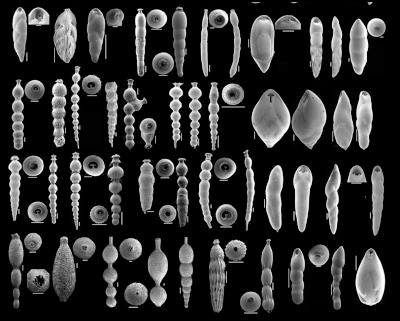Recent Deep Sea Extinction Much Bigger Than Thought
Press Release from Geomarine Research,
Auckland
Recent Deep Sea Extinction Much Bigger Than Thought
A team of Auckland-based geologists from Geomarine Research have just published a 400 page book that shows that the last major extinction period in the deep sea had a much bigger impact than previously thought. The book, published by the Cushman Foundation in Washington DC, gives an account of the team’s global studies over the past 10 years. This youngest period of rapid extinction in the ocean depths occurred during the middle Pleistocene Climate Transition, between 1 million and 600,000 years ago. At that time the global climate changed dramatically with the rapid growth of the northern hemisphere ice cap and onset of much colder ice age periods.
Research leader, Dr Bruce Hayward and his colleagues have been studying the microscopic shells of amoeba-like organisms (called foraminifera) preserved in sediment cored from the ocean floor around the world. Because of their abundance and small size, these shells provide the most complete fossil record of the history of life in the ocean depths.
Hayward and his team have studied the history of these organisms over the last 65 million years in over 25 cores taken from all around the world. They have shown that most of the deep-sea species were widely distributed and lived in all the world’s oceans, including the Mediterranean and Caribbean seas.
In the 1980s and 1990s, geologists in Europe recognised the extinction of 10 species of foraminifera at this time in two core sites in the Atlantic and several in the central Pacific. Over a 10 year period Geomarine Research has now shown that no fewer than 75 species and 30 genera became extinct globally during a 400,000 year period in the middle Pleistocene epoch.
“This is nearly 20% of the diversity of deep-sea foraminifera” says Hayward, “far more than anyone thought likely. Many of the species that we have now shown became extinct were previously thought to be still living. Their extinction was so recent, in geological terms, that the shells of many of the species can often still be found at or near the surface on the deep ocean floor.”
The dark, near-freezing environment of the deep sea is the largest and most stable habitat on Earth. So the Auckland scientsist have been trying to determine what could possibly have caused the selective extinction of five whole families in such a stable seemingly isolated environment, while leaving the remaining 80% of the faunas untouched.
A clue to their extinction comes from the observations that these families declined and disappeared during the coldest parts of the ice age cycles and partly recovered in the intervening warm periods. Thus it was something that happened during the increasingly cold ice age intervals of the middle Pleistocene Climate Transition that caused the extinctions.
Studies on ancient ice cores by northern hemisphere scientists have shown that these colder ice age periods coincided with low levels of carbon dioxide in the atmosphere. Hayward’s team hypothesise that this may have caused the extinctions at water depths of 500-4000 m all around the world.
Most organisms living on the ocean floor rely for food on the rain of dead plankton that floats down from the upper layers of the ocean. “Maybe a group of phytoplankton (microscopic floating plants), all of which require carbon dioxide to photosynthesise, were unable to cope with the low carbon dioxide levels dissolved in the surface layers of the ocean in which they lived” suggests Hayward. “The phytoplankton that may have died out through insufficient carbon dioxide could have been the specific food for our five families of deep-sea foraminifera, thereby causing their extinction as well.”

Geomarine Research geologists
(from left) Jill Kenny, Bruce Hayward and Ashwaq Sabaa, with
their new book that documents the last global extinction in
the deep sea.

Click for big version.
Some of the shells of the amobe-like foraminifera that became extinct on the floor of the world’s oceans between 1 million and 600,000 years ago. Each shell is 0.2-0.5 mm long.
ENDS


 Natural Hazards Commission: Hub Launched To Empower Architects And Engineers To Build Above Code
Natural Hazards Commission: Hub Launched To Empower Architects And Engineers To Build Above Code Harmony Energy: Ceremony Heralds Start Of Construction On New Zealand’s Largest Solar Farm Project
Harmony Energy: Ceremony Heralds Start Of Construction On New Zealand’s Largest Solar Farm Project Stats NZ: Annual Number Of Home Consents Down 7.4 Percent
Stats NZ: Annual Number Of Home Consents Down 7.4 Percent Plains Media: Plains FM Announces Name Change After 37 Years
Plains Media: Plains FM Announces Name Change After 37 Years NIWA: Flooding From Underneath - New Tool Reveals Shallow Groundwater Elevations
NIWA: Flooding From Underneath - New Tool Reveals Shallow Groundwater Elevations Commerce Commission: Commission Concludes Auckland Airport Over-charging By $190 Million
Commerce Commission: Commission Concludes Auckland Airport Over-charging By $190 Million



